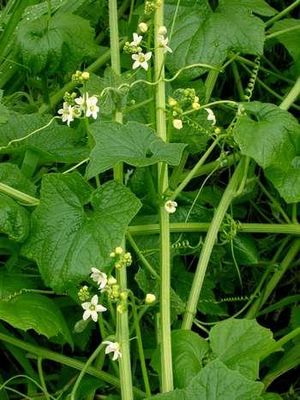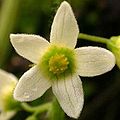Marah oregana
- Latin Name: Marah oreganus
- Family: Cucurbitaceae
- Common Names: coastal manroot
- Codon: MARORE
Contents
Description1
General: Perennial vine from a large woody root; stems herbaceous, leafy, bearing tendrils.
Leaves: Alternate, to 20 cm long, shallowly lobed and cordate at base.
Flowers: White, 6-12 mm across with 5 flaring lobes (or sometimes 6-8); male flowers in racemes, female flowers mostly single in axil at base of racemes.
Fruit: Green, weakly spiny, inflated gourd-like fruits 3-8 cm long with several large seeds inside.
Description 2
Western Wild Cucumber is a member of the cucumber family (family Cucurbitaceae). Cucumbers are herbs, often trailing or climbing by coiled tendrils.
Bloom Period
Flowering: Mid January - May (Oswald and Ahart 2002)
Distribution
Majority of California. Streamsides, washes, shrubby and open areas below 1,600 meters (Hickman 1993).
Habitat
Uses
Chehalis Drug (Dermatological Aid) - Salve of root ash and grease applied to scrofula sores.
Karok Drug (Dermatological Aid) - Poultice of roots applied to bruises and boils. Mendocino Indian Drug (Antirheumatic
(External)) - Seeds and roots used for rheumatism or root rubbed on rheumatic joints.
Mendocino Indian Drug (Dermatological Aid) - Root rubbed on rheumatic joints, boils and swellings.
Mendocino Indian Drug (Poison) - Roots and seeds considered poisonous.
Mendocino Indian Drug (Urinary Aid) - Seeds eaten for urinary troubles.
Mendocino Indian Drug (Venereal Aid) - Seeds and roots used for rheumatism and venereal disease.
Paiute Drug (Eye Medicine) - Decoction of peeled, sliced and dried root used for "sore eyes."
Squaxin Drug (Analgesic) - Infusion of smashed stalks used as a soak for aching hands.
Yurok Food (Beverage) - Young shoots and Polypodium rhizomes used to make tea.
Mendocino Indian Other (Hunting & Fishing Item) - Roots formerly used as fish poison.
Yurok Other (Toys & Games) - Fruit used by children to construct representations of animals by inserting twigs.
Yurok Other (Toys & Games) - Fruit tossed by children at one another in play.
Propogation
Clean seed may be rapidly collected from ripening fruits of after falling to the ground from early to late spring.
Large seeds, weighing 0.5-0.8 grams each, may rapidly be collected from ripening fruits from early-late spring. Pre-Planting Treatments: None, though clean dry seed was placed in dry, cold storage following collection and prior to sowing.
Germination Rate 92% and 85%.
Establishment Phase High germination rates (85-92%) were observed within 3-weeks of planting. Robust seedlings with deep, thick taproots were established by most individuals by the first spring.
Length of Establishment Phase Sprouts were established within approximately 4 weeks.
Active Growth Phase Active growth was observed within 2 weeks after seeding in fall. Plants produced a vigorous clambering vine which died back rapidly and completely by the end of the first spring.
Length of Active Growth Phase Approximately 7 months, from fall through spring, plants senescing by the beginning of summer.
Hardening Phase Hardening is not necessary as the active growth phase starts with the onset of fall rains and plants senesce around the end of spring or beginning of summer.
Harvesting, Storage and Shipping Individuals go dormant following spring-summer dry down and die back to the root. Dormant individuals were placed in dry storage at 60-70 degrees Farenheit.
Length of Storage 2-4 months
Other Look for the mostly 5-lobed white flowers and inflated gourd-like fruits. Compare with grapes (family Vitaceae) which have woody stems and more mumerous minute unshowy flowers. Look for the mostly 5-lobed white flowers and inflated gourd-like fruits. Compare with grapes (family Vitaceae) which have woody stems and more mumerous minute unshowy flowers.
Flowering: Mid January - May (Oswald and Ahart 2002).
Seed collection: March - June/July (seed may be collected on the ground within leaf litter below dried fruits duirng the latter part of the collecting period).
This species has a very high germination rate and rapidly establishes a large, deep taproot with vigorous above ground growth.
Seed
Seed sample from: 2011
Average Measurement: 16.8 x 17 x 8.5
Measurement Range: L: 15 – 18, W: 16 – 18, D: 8 – 9
Features
Shape: Seeds very large, rounded with a pinched looking hilum.
Color: Dark brown, with a lighter brown hilum. Under high magnification seed appears speckled with black.
Surface: Seed covered in very fine velvety hairs. Under high magnification seed appears slightly glossy, but with naked eye, seed is matte.
Latitudinal Cross Section: elliptical ![]()
Longitudinal Cross Section: elliptical ![]()
References
http://plants.usda.gov/java/ClassificationServlet?source=profile&symbol=MAOR3&display=31 http://biology.burke.washington.edu/herbarium/imagecollection.php http://extension.oregonstate.edu/catalog/pdf/pnw/pnw401.pdf http://herb.umd.umich.edu/herb/search.pl http://www.wildflower.org/plants/result.php?id_plant=MAOR3 http://www.calflora.org/cgi-bin/species_query.cgi?where-taxon=Marah+oreganus]
Hickman, James, Ed. 1993.
The Jepson Manual: Higher Plants of California. University of California Press, Berkeley, California.; Oswald, Vern and Lowell Ahart. 2002.
Selected Plants of Northern California and Adjacent Nevada. CNPS



